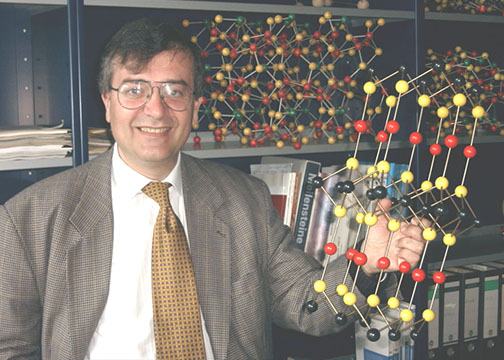Chemistry Professor Mercouri Kanatzidis will lead a recently formed center to house his world-renowned research in materials chemistry. Called the Center for Advanced Materials for Energy and the Environment (CAMEE), it will be the newest center of the Institute for Sustainability and Energy at Northwestern (ISEN), joining the Argonne-Northwestern Solar Energy Research Center (ANSER), Center for Catalysis and Surface Science (CCSS) and Solar Fuels Institute (SOFI).
The focus of the center is to discover and develop new materials that can be used in energy production and conservation, or environmental cleanup and remediation.
Converting waste (heat) into electricity
Kanatzidis has developed the world’s most efficient thermoelectric materials. These materials capture heat, with a focus on waste heat, and convert it into electricity. “That helps to save wasted energy, produce energy from thermal sources and manage energy more efficiently,” says Kanatzidis.
A byproduct of many industrial processes is heat, which is typically lost to thin air. Kanatzidis has developed materials that can capture this heat and turn it into useful electricity. The electricity could then be used to help power the facility itself, improving process efficiency.
Automobiles are another significant source of waste heat. According to Kanatzidis, “Usually about three quarters of the heat that’s created when you burn gasoline goes out the tailpipe. Only about 25% is used for motion. So thermoelectrics are one way to capture that energy and turn it into something useful.”
Cleaning up toxic metals
Kanatzidis is also developing materials that can be used for the efficient cleanup of environmental waste polluted with toxic heavy metals, such as mercury, cadmium, and lead. Small quantities of these materials are difficult to sort and extract from benign or necessary materials, but even small quantities are too large to be safe.
Kanatzidis’ materials perform with a high level of selectivity for this application. They are created to specifically attract the atoms of toxic metals, but not the atoms of other substances. His materials are designed with space inside them – this space accommodates the heavy metals that they’re going to capture.
“When they’re on the nanoscale you can load up the material rapidly with high capacity with the captured metals,” says Kanatzidis. “You want to have a material that, when it’s loaded up, 30-50% of its weight is the waste material – it’s very concentrated so you don’t have to handle a big volume of waste.” Once this material captures the toxic metals, it can be disposed of safely. Because they are so efficient at capturing waste material, it is more economically attractive and could significantly reduce the cost of an expensive cleanup.
Harvesting low-concentration, high-volume mediums
In addition to environmental remediation applications, Kanatzidis is also working on nanomaterials that could capture uranium from nuclear waste and from the sea, where there is a huge amount but it is highly dissolved and challenging to harvest. He is also developing materials that could be used to harvest precious metals from mines.
Kanatzidis is not doing all of this work alone. His new center will include the work of his longtime collaborators at the University, including materials science professors Vinayak Dravid, Chris Wolverton, chemistry professor Kenneth Poeppelmeier, and others.
As CAMEE seeks funding and continues to grow, ISEN will provide portfolio management, strategic planning and development, business and research administration services, and integrated marketing and communications.
“We’d like to leverage ISEN’s resources to make the center more viable, to get more funding, and establish it to have a bigger, better footprint at Northwestern,” says Kanatzidis.
Kanatzidis says his focus has evolved over time from making new materials simply for the challenge, to making things that could create positive change in the world.
“Once you convince yourself that you’ve succeeded in making really novel materials, then the next step is how can we use this skill to do something that would impact society,” he says. “And energy and the environment are always up there in terms of priority. As long as there are humans on earth, they’ll always be worried about energy and the environment.”



